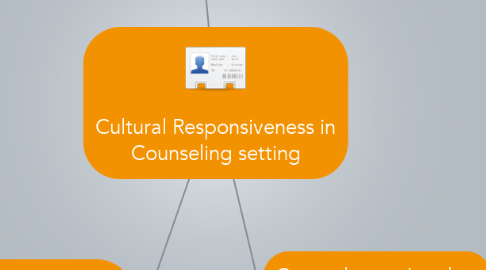
1. Counselors address cultural shock, if appropriate
1.1. Takes place in stages
1.2. Needs preparation
1.3. Understanding of the process
1.4. Willingness to take risk
1.5. Accept the need to modify behavior
2. Counselor's Cultural Competency
2.1. Understand his own culture
2.2. Learn to manage feelings
2.3. Be honest with yourself
2.4. Become aware of judgment
2.5. Gradual process
2.5.1. Ways of Knowing
2.5.1.1. How does your culture acquire information?
2.5.2. Ways of solving problems
2.5.2.1. Some cultures save the mother first!
2.5.3. Ways of communicating
2.5.3.1. e.g.: do not smile in Korea
2.5.4. Ways of learning
2.5.4.1. memorization vs. thinking creatively
2.5.5. Ways of dealing of conflict
2.5.5.1. avoid conflict or see as a positive thing
2.5.6. Ways of using symbols
2.5.6.1. ask about meaning of child's drawing
2.6. Seven Principles by Gary R. Howard
2.6.1. 1. Cultural connection
2.6.2. 2. Faculty is personally inviting
2.6.3. 3. School is physically/culturally inviting
2.6.4. 4. Reinforce academic development
2.6.5. 5. Accommodate differences in instruction
2.6.6. 6. Discipline as instructive, not punitive
2.6.7. 7. Collectivity and individuality at the same time
3. Counselors as Leaders
3.1. Seek ways to understand student rather than to be understood
3.2. Understand communication as therapeutic technique
3.2.1. Verbal
3.2.1.1. voice volume, tone, intonation, rhythm
3.2.1.2. Reflection
3.2.1.3. Pronunciation
3.2.2. Non-verbal
3.2.2.1. Touch
3.2.2.2. Facial expression
3.2.2.3. Eye contact
3.2.2.4. Gestures
3.2.2.5. Posture
3.2.2.6. Body movements
3.2.2.7. Silence
3.3. Learn about cultural factors
3.3.1. Language of context
3.3.1.1. High-context cultures
3.3.1.1.1. Message are highly coded
3.3.1.1.2. Establish social trust first
3.3.1.1.3. Ritualistic and slow
3.3.1.1.4. Ex: Chinese, Japanese, Arab
3.3.1.2. Low-context cultures
3.3.1.2.1. Get to business first
3.3.1.2.2. Value expertise and performance
3.3.1.2.3. Prove competency first
3.3.1.2.4. Ex: U.S.A., Scandinavian, Swiss
3.3.2. Language of time
3.3.2.1. Monochronic
3.3.2.1.1. Linear
3.3.2.1.2. Time is money
3.3.2.1.3. Handle time as a material thing
3.3.2.2. Polychronic
3.3.2.2.1. Value personal involvement
3.3.2.2.2. Solid relationships
3.3.2.2.3. Rank time as less important
3.3.3. Language of space
3.3.3.1. High territoriality
3.3.3.1.1. Ownership of ones body, as if there is a bubble around them
3.3.3.2. Low territoriality
3.3.3.2.1. Contact society
3.3.3.2.2. Enjoy close proximity
